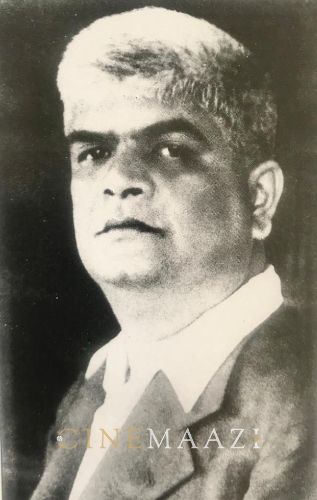Nanasaheb Sarpotdar

Subscribe to read full article
This section is for paid subscribers only. Our subscription is only $37/- for one full year.
You get unlimited access to all paid section and features on the website with this subscription.
Not ready for a full subscription?
You can access this article for $2 , and have it saved to your account for one year.
- Real Name: Narhar Damodar Sarpotdar
- Born: 11 February, 1896 (Nandavali, Bombay Presidency, British India)
- Died: 23 April, 1940 (Poona, Bombay Presidency, British India)
- Primary Cinema: Marathi
Actor, writer and filmmaker of the silent era of cinema, Narhar Damodar—or Nanasaheb Sarpotdar as he was popularly known—had a penchant for historical films. Acknowledged as one of the earliest sculptors of Marathi cinema, he directed more than 25 films in the course of his career such as Prabhavati (1925), Chhatrapati Sambhaji (1925), Thoratanchi Kamala (1927), Prithviraj Sanyogita (1929), Bhimsen The Mighty (1930), and Chandbibi (1931). His production house Aryan Film Company produced over twenty silent pictures.
Born Narhar Damodar on 11 February, 1896 in Nandavali, Bombay Presidency, he was brought up in Pune and Indore. Abandoning formal education, he found work with the Maharashtra Natak Mandali, where he played various roles in plays such as Vatsalaharan, Sairandhri, and Damaji. Urged by his mother to pursue his education in Indore; however, this stint too proved to be unsuccessful. He later joined Achyut Balwant Kolhatkar’s repertory, where he is known to have essayed female roles. Displaying a flair for writing, he penned at least three plays, namely Unad Pendhya, Chandrarao More and Bajiraocha Beta. He was already starting to be noticed as an aspirant writer and fledgling actor.
Eventually, on the recommendation of Ganpatrao Joshi, he joined the newly established Maharashtra Film Company, established by Baburao Painter in October, 1919. He was absorbed as a story-writer and actor. He was also required to train new artistes. Patient and diligent, in 1922 he was rewarded with the lead role in Damaji (1922). He also penned the Marathi titles for films such as Sairandhari (1920), Vatsala Haran (1921) and Damaji. It was during his five-year stint with Maharashtra Film Company that he had the opportunity to closely observe Painter and comprehend the nuances of film direction from him.
He went on to make his directorial debut with Prabhavati (1925), after being invited by Pandurang Taligeri to join Deccan Pictures Corporation. The film was not a huge success. Soon, the production company also folded up, with the partners amicably parting ways. However, his friendship with Taligeri saw the latter invite him to join his United Picture Syndicate at Kirkee. Here, his first directorial was based on his own play—Chandrarao More (1925). It was one of the early films that ran into Censor problems on account of its patriotic theme.
Over the next two years—1925 and 1926—he wrote and directed a record number of nine films for United Picture Syndicate. These included historicals such as Thoratanchi Kamla (1927) and Dha Cha Maa (1926), mythologicals, and also a social that dealt with the plight of untouchables – Maharachi Por (1925). The latter won the hearts of noted luminaries of the time such as Mahatma Gandhi, Sarojini Naidu, Shaukat Ali and Barrister Baptista. He went on to direct Vilasi Kanta (1927) for the Bombay-based Social Pictures. It revolved around a flirtatious wife.
In 1927, he set up his own production company–Aryan Film Company, backed financially by Baburao Kanhere, owner of Bombay’s Kohinoor theatre. The first film he made under his banner was Arya Mahila (1927). It was followed by Udantappu (1927). Over the next five years, until the dawn of the talkie era, he wrote, produced and directed all the films made under the Aryan Film Company banner. He helmed a range of mythological, historical, and social films.
Despite the entry of sound in Indian cinema in 1931, he continued to make silent films for at least a year after the release of the first talkie. These include Bhawan Talwar (1932) and Sultana Chandbibi (1932). The advent of sound saw the Aryan Film Company closing down.
An experienced actor, writer, director and producer, he had also learned photography. It was his Aryan Film Company that had also given talents such as Lalita Pawar their first break. The latter had started out as a child artiste before she began working in his films.
He directed his first talkie for Maharashtra Cinetone, namely Prithviraj Samyukta (1933). Joining Ardeshir Irani's Imperial Film Company in Bombay, he directed two Marathi—Rukmini Haran (1933) and Devaki (1934)— and a Hindi film Chalta Purza (1935). Rukmini Haran had a cast that included Bilimoria, Panditrao Nagarkar, and Bhaurao Datar. In 1938, he directed Sant Janabai for Ravindra Pictures. His comeback attempt with R G Torney’s Saraswati Cinetone’s Bhagwa Zhenda (1939) was unsuccessful.
Producing and directing approximately 24 films from 1928 to 1930, most of his films were successful. However, the end of the silent film era also drew a close to his career in cinema. It saw him explore other avenues. Venturing into the business of hospitality, he started Poona Guest House in 1936 to provide good, economical food to the common man on Lakshmi Road. The food was a hit and, combined with his eloquent personality, Poona Guest House became a favourite place for artists and writers.
With a keen interest in literature, he was an avid reader. He also penned some admirable articles in Mauj Weekly.
Nanasaheb Sarpotdar passed away on 23 April, 1940 in Poona. He was 44.
References
https://www.imdb.com/name/nm0765494/
https://www.cinemaazi.com/feature/nanashaheb-sarpotdar-the-daring-pioneer







.jpg)



